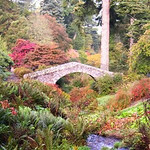Established on this seventy-acre site on the northern side of the Water of Leith in 1820 after being moved from various other sites in the city and the result of Edinburgh explosion of interest in medicine during the seventeenth century, and filled with mature trees and a huge variety of native and exotic plants and flowers, the botanics are most popular simply as a place to stroll and lounge around on the grass.
Towards the eastern side of the gardens, a series of ten glasshouses including the elegant Victorian Palm House, and a contrasting 1960s design with a complex exterior frame of struts and tensioners intended to maximise the amount of light and avoid the need for internal pillars.
Inside, there's an array of palms, ferns, orchids, cycads and aquatic plants, including some huge circular water lilies. Elsewhere in the garden, different themes are highlighted: the large Chinese-style garden, for example, has a bubbling waterfall and the world's biggest collection of Chinese wild plants outside China, while in the northwest corner there's a Scottish native woodland which very effectively evokes the wild unkemptness of parts of the Scottish Highlands and west coast.
A gallery showing changing contemporary exhibitions is housed within the attractive eighteenth-century Inverleith House at the centre of the gardens and, scattered all around, a number of outdoor sculptures, including a giant pine cone by landscape artist Andy Goldsworthy and the striking stainless-steel east gate, designed in the form of stylized rhododendrons.
Parts of the garden are also notable for some great views: the busy Terrace Café beside Inverleith House offers one of the city's best views of the castle and Old Town's steeples and monuments stretching up the hill. Ideal location on a warm day.
Website
http://www.rbge.org.uk/Address Details
- Inverleith Row
- EH3 5LR


